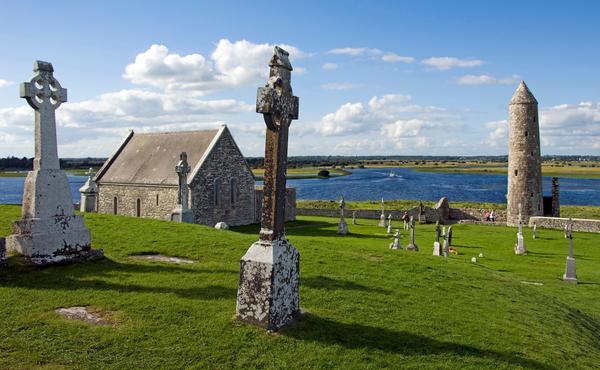Clonmacnoise Historic Monastery
Clonmacnoise is an early Christian monastic site, founded by St Ciarán in 544. Strategically located at the intersection of an esker (formed during the ice age) and the river Shannon, it became an important centre for religious life and studies. It grew to a peak of up to 2,000 men during the 11th century before its decline. It has a history of enduring artwork in metal and stone, as well as one of struggle against attacks. It has several high crosses, dating from circa 800, as well as two round towers, and the ruins of a cathedral and seven churches.
St Ciarán was born around 516 in county Roscommon and became a teacher. He later left Clonard and went to Aran and was ordained a priest and studied under St Enda of Aran who advised him to build a church and monastery in the middle of Ireland.
In 544, St Ciarán and his ten companions built their first church in Clonmacnoise. It was a small wooden structure, but the start of great things to come. Unfortunately for St Ciarán, he contracted a plague, and died within 7 months of arrival.
Plague also claimed a number of other students and teachers at the monastery at the end of the seventh century, but in spite of this the numbers of men joining the monastery continued to grow. The monastery came under attack at various points in its history, by the Irish, the Vikings and the Normans. Earlier wooden buildings were replaced with more robust stone structures and artisan skills in stonework, carving and metalwork were developed. Famous works from Clonmacnoise are the Clonmacnoise Crozier (on display at the National Museum of Ireland in Dublin) and the Cross of the Scriptures which is on the Clonmacnoise site.
The Cross of the Scriptures is 4 metres high and has panels of carvings depicting various scenes, including the Crucifixion, Christ in the tomb and the Last Judgement.
Look out for the many delicate stone carvings on tombstones, crosses, doorways etc. Imagine the time, effort and skill which went into their production.
The Cathedral is the largest of the churches on the site, and it dates back to 909. Look out for the Whispering Arch Gothic-style doorway.
If you are a curious visitor, interested in what drove the men who studied and worked here, what kept them going in spite of frequent attacks, then come along and find out. You will also discover what led to the eventual decline of Clonmacnoise after about seven hundred years.
There is a visitor centre on site containing exhibitions, artefacts, audio-visual displays and a guided tour. There is an entrance fee, however the information provided by the visitor centre and the guided tour help set a necessary context for what is on site and makes the visit more meaningful, memorable and worthwhile. There is also a gift shop and café.
Clonmacnoise is located on the banks of the river Shannon, 22km by road south of Athlone (about a 29-minute drive). From Athlone take the R446 south and join the N62 south. At Ballinahown fork right onto the R444 to Clonmacnoise. Click the map pin icon to view the location on a map.
For details of opening hours and admission prices, click the "More info" button below.

